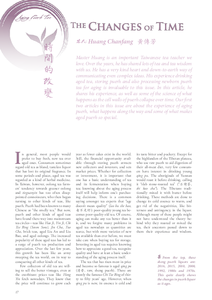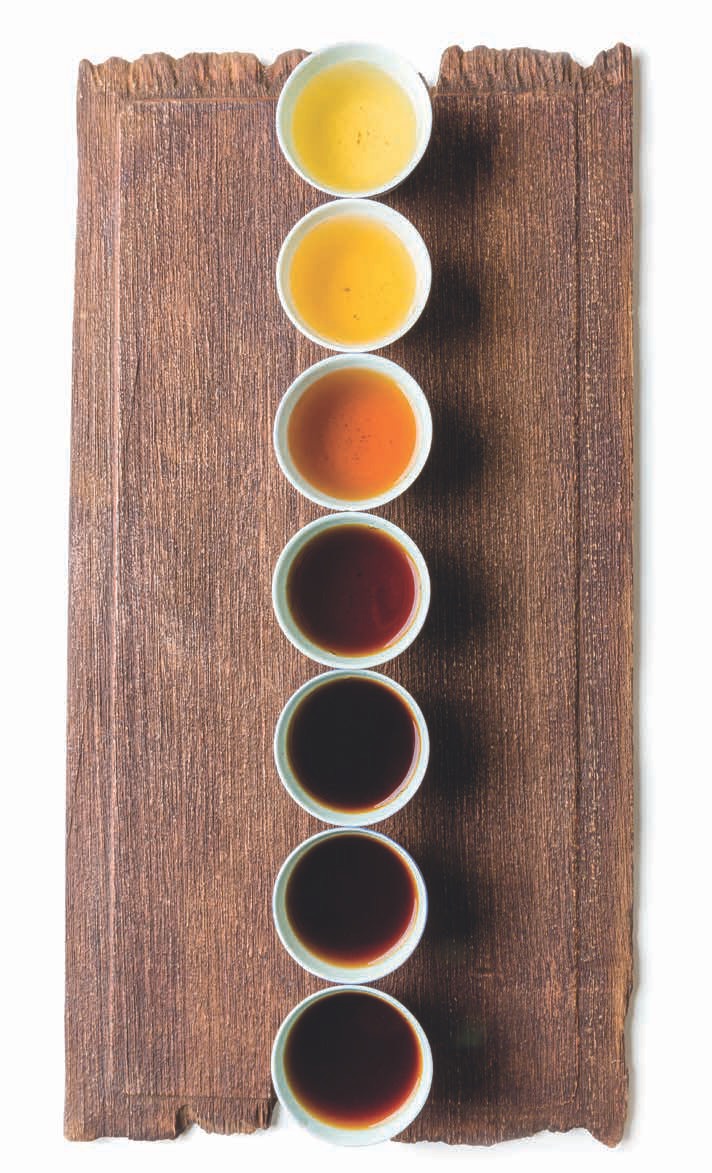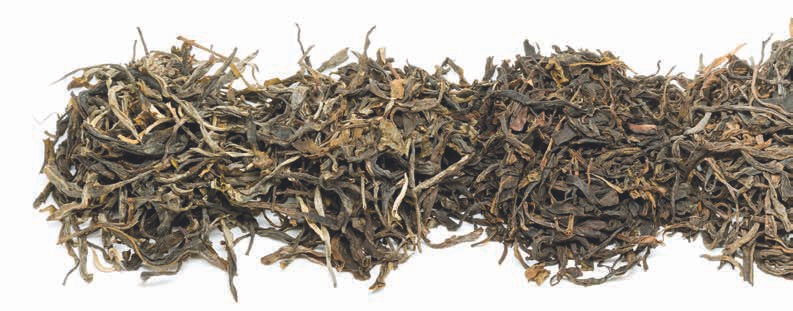
 |
|
In general, most people would prefer to buy fresh, new tea over aged ones. Consumers sometimes regard old tea as bland, tasteless liquor that has lost its original fragrance. In some periods and places, aged tea was regarded as a kind of herbal medicine. In Taiwan, however, oolong tea farmers' tendency towards greener oolong and tieguanyin has too often disappointed connoisseurs, who then began turning to other kinds of teas, like puerh. Puerh had been known to many Chinese as "the smelly tea." But now, puerh and other kinds of aged teas have found there way into mainstream tea circles - teas like Hao Ji, Yin Ji, Chi Tze Bing (Seven Sons), Jin Cha, Tuo Cha, brick teas, aged Liu An and Liu Bao, and aged oolongs. The increased popularity of these aged teas has led to a surge of puerh tea production and appreciation. Over the last few years, this growth has been like an army sweeping the tea world, on its way to conquering all other kinds of tea.
Few collectors of old tea are willing to sell the better vintages, even at the exorbitant prices teas like Hong Yin fetch nowadays. They know that the price will continue to grow each year as fewer cakes exist in the world. Still, the financial opportunity available through storing puerh attracts new collectors and investors, and sets market prices. Whether for collection or investment, it is important that one has a basic understanding of tea and its fermentation when buying tea; knowing about the aging process itself will help inform one's purchasing decisions. There is a common saying amongst tea experts that "age doesn't mean quality" (lao bu she hao, 老不是好): poor-quality young tea becomes poor-quality old tea. Of course, aging can make any tea better than it is, and we forgive many problems in aged tea nowadays as quantities are scarce, but with more varieties of new tea available than ever before, we must take care when buying tea for storage. Investing in aged tea requires knowing how to appreciate a good tea, recognize quality and have at least a basic understanding of the aging process itself.
The tea that has risen most in price and become so famous is aged qing pu (清普, raw, sheng puerh). These are mostly the famous Chi Tze Bing of thirty to fifty years' age. However, when qing pu is new, its essence is cold and its taste bitter and puckery. Except for the highlanders of the Tibetan plateau, who use raw puerh to aid digestion of their all-meat diet, very few consumers have interest in drinking young qing pu. The aboriginals of Yunnan would roast it before drinking, calling it "slab stone-roasted tea" ("石烤茶, shi kao cha"). The Tibetans traditionally mixed it with butter before drinking. These methods are done to change its cold essence to warm, and get rid of the negativities, like bitterness and astringency, in the liquor. Although many of these people might not have understood the theory behind why they roasted or mixed the tea, their ancestors passed down to them their experience and wisdom. The owners of teahouses in Hong Kong came up with their own solution to the problems inherent in new qing pu: they stored the puerh tea cakes for some time in hills and basements where the humidity was high, and fermented it through wetter storage. They found that this method of storage removed the bitterness and improved the flavor and liquor dramatically. If the "storage smell" was too strong, they mixed the tea with chrysanthemum flowers, creating another way to enjoy puerh, today called, "Ju Pu Cha (菊普茶)."

The craze for aged puerh in Taiwan has been qing pu. This is the tea that has become famous for its enjoyment and financial appreciation. Of course, its value is, in part, determined by the fact that there is less stock each year, but, nonetheless, the more important reason vintage puerh is worth so much is because of its mellow, thick, soft and elegant flavor that is beyond any other kind of tea. Its liquor is deep ruby and shimmers as such, attracting any tea lover's attention. But how did the tea change so drastically? Once a cold, bitter tea that puckered the mouth, it has become smooth and deep. How did this miraculous transformation occur?
While qing pu ages, it is almost constantly in a state of change caused by cellular breakdown. All cells are protected by a cell wall. Some cell walls in plants are very thin and fragile, like those of most vegetables, fruits and cereals. Just cooking it releases the valuable nutrients inside the cells, and these plants rot quickly and easily. Some cell walls, on the other hand, are not so easily broken down. Some herbs and spiral algae must be treated using a high-tech process in order to get the most out of consumption. Another way for firmer cell walls to break down is time, and aging of puerh occurs this way. Over the course of many years, the plant will oxidize and decompose, resulting in cellular breakdown. When the cell walls of puerh leaves break down, the material inside the cells is released. The more of this "vegetable fat" released, the smoother the tea will be. The more sugars that are released, the sweeter the tea will be; and the more scented oil is released, the more obvious the fragrance will be. Besides these flavor enhancements, amino acids and other trace elements are released from the broken down cells, all of which benefit the human body. Likewise, harmful ingredients found in tea, like caffeine and tannic acid, are volatized by the decomposition. The jerky taste and pucker is gone, and the bitter coldness has turned into soft warmth. As the tea ages, the molecules shrink, making it smoother and more pleasurable to drink.
Temperature, humidity and oxygen levels play a significant role in the decomposition of tea. If any of these factors is slowed or sped up too much, the tea will not be as good. The same qing pu that has been aged in a way capable of attracting attention and investment, can turn people away if it is stored improperly. Collectors must study the proper procedure for storing their tea, to ensure that it will maintain its quality over time. More is understood about storage than ever before, and an increased amount of information is becoming available to the consumer.
People often ask what makes puerh tea so different than other teas, like Long Jing, Assam tea or oolong tea, as far as its "ageability" is concerned. One of the major differences between puerh and these other kinds of tea is that they are all single-breed. No matter how long these other teas are stored, it is still easy to distinguish which kind of tea they are and from where they came. One might even be able to predict their flavor in the future. But puerh tea is not nearly as simple; it is variant and difficult to ascertain. The flavor of puerh may change the next day. Sometimes every steeping is different than the previous one. A cake of puerh will have completely different flavors two years from now, and again in five and so forth. Why? Well, a big part of this mystery is answered in the origin of puerh tea. Puerh tea comes from a different type of tea plant than other teas: arbor trees. These trees have bigger leaves, with more variation in size, even on the same branch. Puerh tea is propagated sexually, rather than by cutting, which means that every single tree is a unique breed.


Although some genetic reproduction via cuttings is found on modern plantations, this isn't the way higher quality puerh teas, past or present, have been made. Much of these plantations began as a result of the rising demand and price index of the material used to make puerh tea cakes.
In the traditional way, tea is picked from a garden and placed together in a pile. The average qing pu cake may contain about 1000 leaves. Combined with the fact that every tree is an independent and idiosyncratic breed, this means that a cake could have anywhere from one to one thousand different breeds in it. If one tea garden produced 9000 cakes, it would be impossible to find two cakes identical in flavor or fragrance, though they would share the common characteristics of tea from that area. Only if all the raw material was taken from a single tree would the cakes be truly identical. However, to help maintain regularity in production, many cakes contain a blend of raw materials. Tea masters choose different raw materials, some with strength of fragrance, some of flavor and some of sweetness, perhaps, and blend them together. Not only do they compliment each other, they also bring a kind of consistency to the production that is not otherwise there.
Whether blended or not, it is very difficult indeed to predict what kind of changes will occur in a cake over time, though blended cakes are even more difficult. Even if all the storage factors are perfect, the differences from cake to cake make any prediction near impossible. Generally, if tea is composed in a skillful and knowledgeable manner, using higher quality raw material, its essence will get better and better over time, as long as the storage environment is relatively healthy.
The difficulty in ascertaining what in fact will be a good tea years down the road has flooded the market with tons of very poor-quality qing pu. Producers take advantage of this difficulty and lack of consumer knowledge, selling large quantities of poor-quality puerh tea. This is also leading to a degradation of the environment, that is similar to what occurred with Taiwanese oolong. Consequently, many tea masters recommend that beginners start by learning about shou puerh. Shou tea is produced using a process called "wo dui (渥堆)," which artificially ferments the tea leaves in a relatively short period of time. One needs to be careful that the process was done hygienically, as poor-quality shou tea can have harmful microbiotic activity. Still, determining which shou tea is good and healthy is a relatively easy endeavor, especially when compared to the job of determining which qing pu to store for later consumption. Since qing pu is not really healthy or enjoyable when it is too new (one should wait until it is ripe) and so difficult to purchase given the tidal wave of low-quality tea that has flooded the market recently, it is important that beginners buy in small quantities as they develop their palates.
Knowing how and why vintage Puerh tea ages helps inform the consumer about how to purchase tea for storage. The increased interest in Puerh has caused a rise in information and research globally, and we can only hope that this trend will continue. As we learn more about aged and aging Puerh tea, this genre of tea will continue to improve, ensuring that future generations are left excellent quality teas to inspire them - just as we inherited the great teas of our ancestors.
